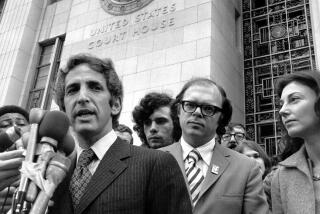Who Lost Nicaragua? : BANANA DIPLOMACY: The Making of American Policy in Nicaragua 1981-1987 <i> by Roy Gutman (Simon & Schuster: $19.95; 404 pp.; 0-671-60626-3) </i>
When Ronald Reagan moved from Pacific Palisades to Washington in 1981, 18 months after the Sandinistas won their insurrection against the Somoza dynasty in Managua, Nicaraguaâs principal foreign relationship was still with the United States. We were, as we had always been, Nicaraguaâs major trading partner. Nicaraguans who could afford it sent their children here to be educated. Most of Nicaraguaâs foreign aid came from the United States, yielding crucial, if peaceful, influence to us in Nicaraguan affairs. Despite American support for the oppressive Somozas stretching over four decades, our two countries remained commercially, diplomatically and culturally interwoven 1 1/2 years after the triumph of the Sandinista revolution.
President Reagan, who had proclaimed his opposition to the Sandinistas even before he announced his candidacy for the Republican nomination in 1980, immediately set out to change all this.
In âBanana Diplomacy,â Roy Gutman shows how the President did it. Gutman, the national security correspondent for Newsday, has amassed a volume of data and detail unapproached by anyone writing about current U.S. policy in Central America. âThe story of the Reagan Administration decision to back the anti-Sandinista rebels is a case study of the perils of fighting strategic battles in secret, on the cheap, and by proxy.â
Gutmanâs text is fascinating and complex, resembling more closely the court intrigues around Louis XIV than the conventional policy development of an American presidency.
Presidential enmity to the Sandinistas was, from the start, absolute. Surprisingly, however, there was never a single policy toward Nicaragua that would have enabled the Presidentâs subordinates to formulate a coherent strategy. Instead, Gutman describes a host of policies, each pursued for a time, then discarded, then resurrected, then pushed simultaneously with other, often contradictory, policies.
The Administration that Gutman shows us looks like a team of skywriters assigned to inscribe an advertisement for a tanning oil above a beach filled with idle Sunday bathers. Each of the planes has been given a different letter to make, and its vapor trail manages to draw that letter fairly legibly. But the letters all come from different words, and when they are placed side by side, turn out not to spell anything at all. Reaganâs âsystem invited indiscipline and competition,â Gutman writes, while the President himself âstayed aloof from the policy process and laid out only general guidelines but no clear lines of authority.â
U.S. policy toward Nicaragua becomes as indecipherable as the scrambled letters above the beach. The Sunday bathers look up at the sky and scratch their heads, while the skywriters look at what they have wrought and realize they have confused not only the bathers but one another: âThe making of U.S. policy in Nicaragua was characterized throughout by duplicity, secrecy, and pretense.â Eventually, when the Iran-Contra scandal breaks like a typhoon over the Reagan skywriters and beachgoers alike, everyone scatters for cover. When we look up again, the letters that never spelled anything have all been blown back into air anyway.
Youâll find your old favorites here--the CIAâs William Casey and Caseyâs faithful pooch Ollie North; presidential fall guys Robert McFarlane and John Poindexter; Secretary of State George (âWho, me?â) Shultz; Nicaraguan policies dragon lady Jeane J. Kirkpatrick and the amazing unthinkable Elliott Abrams. But Gutman also adds materially to our knowledge of the roles of less well-known key players such as the State Departmentâs Thomas Enders, Tony Motley and Craig Johnstone; the National Security Councilâs William Clark and Constantine Menges (known as Constant Menace to those who disagreed with his war hawk advice); the Honduran General Gustavo Alvarez Martinez; Contra military chief Enrique Bermudez Varela; and American free-lance Contra manipulators John Carbaugh and Nat Hamrick.
Among them, they try all the policies, tell lies to Congress and the public, mount Contra operations sometimes with military aims and sometimes as photo opportunities. They wage war while talking peace, promote âdemocracyâ when what they mean is restoration of somocismo , and occasionally even talk war while secretly negotiating peace.
Most damaging from their own point of view, and no doubt most entertaining from the Sandinista side, they work against one another. At one point a State Department official flies to Managua and tells the Sandinistas not to listen to anything one of his rivals says. At another point, Casey deceives Congress while McFarlane deceives Shultz while North deceives McFarlane. Where are you, Rosencrantz and Guildenstern, when we need you most? What a pity this book appears during the writersâ strike, since it may be months before anyone can start on the miniseries.
In one year alone, the Contras were sent five conflicting signals by their Reagan Administration sponsors. First, mount a major offensive if you want our help. Second, hold the phone, we canât resupply you right now, and anyway you have to clean up your atrocity act for Congress. Third, OK, go for it again with infiltration and guerrilla actions, but we donât have any money for you because our citizens, the numbskulls, canât seem to figure out what we really want. Fourth, mark time and keep out of our way while we mine the harbors, but weâll give you credit for it. Fifth, hereâs some cash now, never mind broad-based infiltration, just get in there and grab a specific piece of land so we can recognize your government and call it âFree Nicaragua.â The Contras were left baffled, and Congress never knew exactly what it was supposed to support.
It was policy by lurch. One of the more revealing scenes was a press conference at a glitzy Ft. Lauderdale hotel, where a new team of Contras and pro-Contra Americans was presented to what was hoped would become an adoring public. For the occasion, in order to present a more peace-loving and liberal image, the CIA liaison changed his name from âPhilip Masonâ to âTony Feldman.â Same guy, same goal, new alias. The WASPy âMasonâ may be a tough bugger, but you know what âFeldmanâ is, and theyâre softies, right? But itâs an adorable ethnic stereotype that all of us with any Jewish heritage can be hugely proud of Elliott Abrams for combatting so masterfully.
It is with Abrams that Reagan finds the personification of what would be his policy if he had ever dared enunciate it. Abramsâ strategy was three-pronged: First, isolate Nicaragua from its traditional friends in the West and force it to depend on Moscow and Havana; second, gain credibility for the Contras as a capable political and military force; third, get the other Central American countries to follow the U.S. lead. He succeeded largely in the first but failed so utterly in the second and third that he has been left impaled on that first prong, and no one has yet done him the favor of firing him.
This is a book for insiders that outsiders will admire and be enlightened by. Gutmanâs research on the Manzanillo negotiation, the Contadora peace process and the Nicaraguan elections of 1984 is original and illuminating. His efforts are unsurpassed in the sheer quantity of his interviews and excavation of valuable record.
Conflicting versions of the same event at times left me confused as to which one Gutman wanted me to believe. For an insider journalist in Washington, access to power is oxygen, and Gutman has thrived on the degree of access he has achieved. The problem with this approach is that it leaves him with little perspective outside that of his sources themselves. The book never questions, for instance, the intrinsic worth of the anti-Communist crusade, just how âMarxist-Leninistâ the Sandinistas really are, or the morality of hiring some Nicaraguans to kill other Nicaraguans. What Gutman does accomplish, though, is major. He has meticulously pieced together the details of the most grievous foreign policy disaster of the Reagan years.
âI want to be the first guy to reverse a Communist revolution,â Elliott Abrams said, later adding that âAnyone who believes that this President will go out of office with the Sandinistas in power doesnât know Ronald Reagan.â Well, theyâve got less than half a year to turn it around.
Otherwise, when he comes back to the Santa Barbara mountains for the rites of mummification, someone is simply going to have to tell the future former President: âLook, sir, we no longer have any trade with Nicaragua, we give them no aid, we have no leverage there at all, and they send their best students to be educated in Eastern Bloc countries, where they get their aid and do much of their trade. All this is the opposite of the way it was in 1981, sir, and it happened on your watch. I hate to tell you this, R.R., I really do, but you lost Nicaragua.â
If you have a molecule of compassion in you, youâll pray it wonât be Elliott Abrams who has to tell him.
More to Read
Sign up for Essential California
The most important California stories and recommendations in your inbox every morning.
You may occasionally receive promotional content from the Los Angeles Times.










